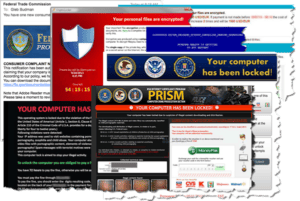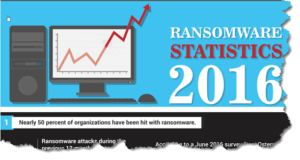Ransomware on the rise
 Ransomware on the rise: a reader asks…
Ransomware on the rise: a reader asks…
I’m worried about a ransomware attack on my home computer after reading how many people are getting attacked this way. How can I best protect my computer?
First let me say that a home computer has been much less likely to be targeted than business computers in the past. Going forward, I think it’s safe to say that any computer is at risk, as these type of attacks are most often received as an email or email file attachment, and emails can continue to be forwarded around the world for years by hapless victims as well as nefarious hackers. Some Nigerian Prince email scams have been circling the globe continuously for over 20 years not and show no signs of dying off.
 Your best protection against being victimized by ransomware is to change your email behavior. First, never click on a link in an email blindly. In most cases if you hover over the link you’ll see the URL (such as https://positek.net/ransomware-on-the-rise) either in a tooltip (tiny popup) or at the bottom of the web page. Rather than clicking on links in email, I will open my web browser and type the URL into the browser to visit that website. Last year 59% of ransomware attacks came through email. Second, stop surfing the internet indiscriminately. Search engines are great at showing you relevant search results, but in most cases they don’t certify that the websites listed haven’t been hacked. Last year 24% of ransomware attacks came from a website or web application.
Your best protection against being victimized by ransomware is to change your email behavior. First, never click on a link in an email blindly. In most cases if you hover over the link you’ll see the URL (such as https://positek.net/ransomware-on-the-rise) either in a tooltip (tiny popup) or at the bottom of the web page. Rather than clicking on links in email, I will open my web browser and type the URL into the browser to visit that website. Last year 59% of ransomware attacks came through email. Second, stop surfing the internet indiscriminately. Search engines are great at showing you relevant search results, but in most cases they don’t certify that the websites listed haven’t been hacked. Last year 24% of ransomware attacks came from a website or web application.
More and more websites are starting to take steps to make sure they’re well-protected. But there are still plenty of dodgy websites whose webmasters have neglected even the most basic cybersecurity practices. This is especially true of small business, individual/person websites, and non-profit organizations. And of course, truly dodgy websites that push fake news, porn, etc.
 For the math-minded, the above stats for ransomware attacks that I cited don’t add up to 100%. Those stats are from http://www.armadacloud.com/roundup-ransomware-statistics-2016/ and The remaining 17% come from social media (4%) USB sticks (3%), business applications (1%) and ‘we don’t know’ (9%).
For the math-minded, the above stats for ransomware attacks that I cited don’t add up to 100%. Those stats are from http://www.armadacloud.com/roundup-ransomware-statistics-2016/ and The remaining 17% come from social media (4%) USB sticks (3%), business applications (1%) and ‘we don’t know’ (9%).
For email file attachments, the most common infected files are Microsoft Word documents (especially with macros enabled), Adobe PDFs, and compressed (.zip) files. At this point in time, there are too many good alternatives to sending file attachments to email (Dropbox, Google Drive etc.), so you shouldn’t send anyone a file attachment, and you shouldn’t open one you receive from anyone else. If you want to share a photo or photo album with family and friends, then by all means put the album online and invite that person to view the photo or album. Google Photos is great for that, and pretty ubiquitous. Mac users can use iCloud. For folks wanting to force their family and friends to pay for downloading the photos, you can use Shutterfly. And of course, there are all the social media image sharing sites like facebook, instagram, & flikr. Sharing photos via email is so 20th century.
59% of ransomware attacks come via an email or email file attachment (often Word documents with macros, or PDFs)
Another 24% come from a website you visit (or web application)
The remainder come from infected social media, USB sticks and business applications
This website runs on a patronage model. If you find my answers of value, please consider supporting me by sending any dollar amount via:
or by mailing a check/cash to PosiTek.net LLC 1934 Old Gallows Road, Suite 350, Tysons Corner VA 22182. I am not a non-profit, but your support helps me to continue delivering advice and consumer technology support to the public. Thanks!






